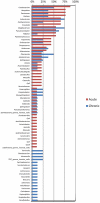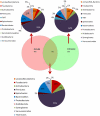Comparing the bacterial diversity of acute and chronic dental root canal infections - PubMed (original) (raw)
Comparative Study
Comparing the bacterial diversity of acute and chronic dental root canal infections
Adriana L Santos et al. PLoS One. 2011.
Abstract
This study performed barcoded multiplex pyrosequencing with a 454 FLX instrument to compare the microbiota of dental root canal infections associated with acute (symptomatic) or chronic (asymptomatic) apical periodontitis. Analysis of samples from 9 acute abscesses and 8 chronic infections yielded partial 16S rRNA gene sequences that were taxonomically classified into 916 bacterial species-level operational taxonomic units (OTUs) (at 3% divergence) belonging to 67 genera and 13 phyla. The most abundant phyla in acute infections were Firmicutes (52%), Fusobacteria (17%) and Bacteroidetes (13%), while in chronic infections the dominant were Firmicutes (59%), Bacteroidetes (14%) and Actinobacteria (10%). Members of Fusobacteria were much more prevalent in acute (89%) than in chronic cases (50%). The most abundant/prevalent genera in acute infections were Fusobacterium and Parvimonas. Twenty genera were exclusively detected in acute infections and 18 in chronic infections. Only 18% (n = 165) of the OTUs at 3% divergence were shared by acute and chronic infections. Diversity and richness estimators revealed that acute infections were significantly more diverse than chronic infections. Although a high interindividual variation in bacterial communities was observed, many samples tended to group together according to the type of infection (acute or chronic). This study is one of the most comprehensive in-deep comparisons of the microbiota associated with acute and chronic dental root canal infections and highlights the role of diverse polymicrobial communities as the unit of pathogenicity in acute infections. The overall diversity of endodontic infections as revealed by the pyrosequencing technique was much higher than previously reported for endodontic infections.
Conflict of interest statement
Competing Interests: The authors have declared that no competing interests exist.
Figures
Figure 1. Relative abundance of the different bacterial phyla in acute and chronic dental root canal infections.
A, overall data. B, data according to the clinical condition. Phylogenetic classification was based on Ribosomal Database Project Classifier analyses.
Figure 2. Prevalence of the different genera detected in samples from acute and chronic dental infections.
Figure 3. Venn diagram for overlap between observed OTUs at 3% divergence in acute and chronic dental root canal infections.
The number of OTUs exclusively found in acute samples was 486 and in chronic samples was 265. The number of OTUs shared between acute and chronic infections was 165. Percentage of shared OTUs was 18%. Data are also represented by the phyla which the detected OTUs belong to. Data regarding genera are shown as supplementary material.
Figure 4. Cluster (A) and PCoA (B) analyses of acute (symptomatic) and chronic (asymptomatic) dental root canal infections.
Although a high interindividual variability can be observed, some samples tended to group together according to the type of infection.
Similar articles
- Microbial transformation from normal oral microbiota to acute endodontic infections.
Hsiao WW, Li KL, Liu Z, Jones C, Fraser-Liggett CM, Fouad AF. Hsiao WW, et al. BMC Genomics. 2012 Jul 28;13:345. doi: 10.1186/1471-2164-13-345. BMC Genomics. 2012. PMID: 22839737 Free PMC article. - Pyrosequencing analysis of the apical root canal microbiota.
Siqueira JF Jr, Alves FR, Rôças IN. Siqueira JF Jr, et al. J Endod. 2011 Nov;37(11):1499-503. doi: 10.1016/j.joen.2011.08.012. Epub 2011 Sep 16. J Endod. 2011. PMID: 22000451 - Microbial analysis in primary and persistent endodontic infections by using pyrosequencing.
Hong BY, Lee TK, Lim SM, Chang SW, Park J, Han SH, Zhu Q, Safavi KE, Fouad AF, Kum KY. Hong BY, et al. J Endod. 2013 Sep;39(9):1136-40. doi: 10.1016/j.joen.2013.05.001. J Endod. 2013. PMID: 23953286 - Present status and future directions: Microbiology of endodontic infections.
Siqueira JF Jr, Rôças IN. Siqueira JF Jr, et al. Int Endod J. 2022 May;55 Suppl 3:512-530. doi: 10.1111/iej.13677. Epub 2022 Jan 13. Int Endod J. 2022. PMID: 34958494 Review. - Diversity of endodontic microbiota revisited.
Siqueira JF Jr, Rôças IN. Siqueira JF Jr, et al. J Dent Res. 2009 Nov;88(11):969-81. doi: 10.1177/0022034509346549. J Dent Res. 2009. PMID: 19828883 Review.
Cited by
- Who is in the driver's seat? Parvimonas micra: An understudied pathobiont at the crossroads of dysbiotic disease and cancer.
Higashi DL, Krieger MC, Qin H, Zou Z, Palmer EA, Kreth J, Merritt J. Higashi DL, et al. Environ Microbiol Rep. 2023 Aug;15(4):254-264. doi: 10.1111/1758-2229.13153. Epub 2023 Mar 30. Environ Microbiol Rep. 2023. PMID: 36999244 Free PMC article. Review. - Microbial transformation from normal oral microbiota to acute endodontic infections.
Hsiao WW, Li KL, Liu Z, Jones C, Fraser-Liggett CM, Fouad AF. Hsiao WW, et al. BMC Genomics. 2012 Jul 28;13:345. doi: 10.1186/1471-2164-13-345. BMC Genomics. 2012. PMID: 22839737 Free PMC article. - Bacterial diversity in primary infected root canals of a Chinese cohort: analysis of 16 S rDNA sequencing.
Hu Z, Xiang Y, Wei Y, Gu X, Leng W, Xia L. Hu Z, et al. BMC Oral Health. 2023 Nov 27;23(1):932. doi: 10.1186/s12903-023-03618-3. BMC Oral Health. 2023. PMID: 38012618 Free PMC article. - Microbiological profile and antimicrobial susceptibility pattern of infected root canals associated with periapical abscesses.
Sousa EL, Gomes BP, Jacinto RC, Zaia AA, Ferraz CC. Sousa EL, et al. Eur J Clin Microbiol Infect Dis. 2013 Apr;32(4):573-80. doi: 10.1007/s10096-012-1777-5. Epub 2012 Dec 6. Eur J Clin Microbiol Infect Dis. 2013. PMID: 23224675 - Important impact of gingival and periodontal conditions on outcomes in SCT recipients.
Allareddy V, Venugopalan SR, Eswaran SV, Rampa S, Anamali S, Nalliah RP, Shin K, Allareddy V, Elangovan S. Allareddy V, et al. Bone Marrow Transplant. 2015 Apr;50(4):604-6. doi: 10.1038/bmt.2014.311. Epub 2015 Jan 19. Bone Marrow Transplant. 2015. PMID: 25599170 No abstract available.
References
- Siqueira JF., Jr . London: Quintessence Publishing; 2011. Treatment of endodontic infections.
- Robertson D, Smith AJ. The microbiology of the acute dental abscess. J Med Microbiol. 2009;58:155–162. - PubMed
- Siqueira JF., Jr Endodontic infections: concepts, paradigms, and perspectives. Oral Surg Oral Med Oral Pathol Oral Radiol Endod. 2002;94:281–293. - PubMed
- Sundqvist G. Umea, Sweden: University of Umea; 1976. Bacteriological studies of necrotic dental pulps [Odontological Dissertation no.7].
Publication types
MeSH terms
LinkOut - more resources
Full Text Sources
Medical



